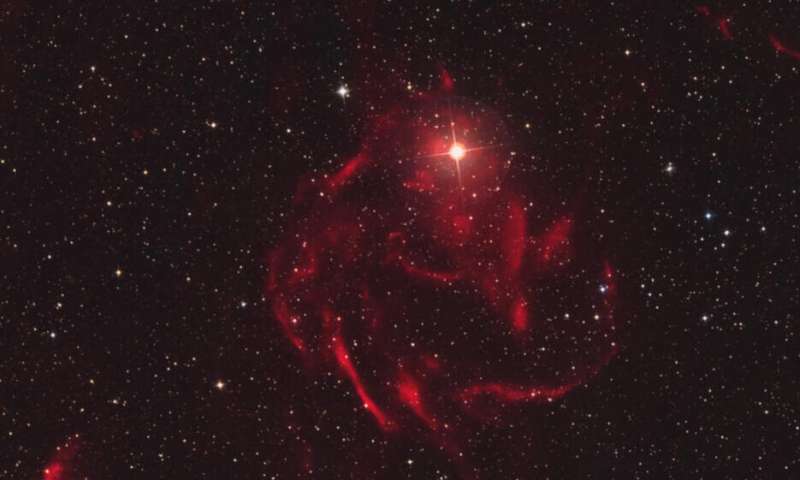Most Universe Today readers are familiar with nebulae. They’re gaseous structures lit up with radiation from nearby stars, and they’re some of nature’s most beautiful forms.
With the help of amateur astronomers who laid the groundwork, an international team of astronomers have discovered a new type of nebulae around binary stars that they’re calling galactic emission nebulae.
The binary star YY Hya is at the center of this discovery. YY Hya is a periodic variable star consisting of a K dwarf star and a hot white dwarf (WD) partner. The stars are nestled in a shared envelope of gas given off by the star that eventually became a white dwarf. Before that, it went through a red giant phase when it dispersed its outer layers of gas into space. Inside this common envelope, both stars continue to evolve as if they were alone, with the stellar radiation lighting up the dispersed gas.
The study presenting this discovery is titled “YY Hya and its interstellar environment” and is published in Astrophysics and Astronomy. The lead author is Stefan Kimeswenger from the Department of Astro and Particle Physics at Innsbruck University, Austria.
In a press release, Kimeswenger said, “Toward the end of their lives, normal stars inflate into red giant stars. Since a very large fraction of stars is in binary pairs, this affects the evolution at the end of their lives. In close binary systems, the inflating outer part of a star merges as a common envelope around both stars. However, inside this gas envelope, the cores of the two stars are practically undisturbed and follow their evolution like independent single stars.”
Previous discoveries paved the way for this one. Astronomers have found binary stars in this same arrangement but without a fully developed envelope. The reason they’ve never seen one could be because of the size of the envelope.

The envelope is vast, over 15 light-years across. At that size, astronomers expect that the envelope would be distorted and disrupted by other stars. But YY Hya is above the galactic plane and undisturbed by other gas clouds.
“The diameter of the main cloud is 15.6 light-years across, almost 1 million times larger than the distance of the earth to the sun and much larger than the distance of our sun to its nearest neighbouring star. Moreover, fragments as large as 39 light-years apart have also been found. Since the object lies slightly above the Milky Way, the nebula was able to develop largely undisturbed by other clouds in the surrounding gas,” Kimeswenger said.
The size of these common envelopes could also inhibit their discovery. This one is larger than the field of view of modern telescopes. “They are too large for the field of view of modern telescopes, and at the same time, they are very faint. Moreover, their lifetime is rather short, at least when considered in cosmic time scales. It is only a few hundred thousand years,” Kimeswenger said.

This discovery began with a group of French and German amateur astronomers. They were examining digitized historical astronomical images from the 1980s. They were looking for unknown objects when they found a fragment of a nebula.
They took that finding to experts at the University of Innsbruck’s Department for Astro and Particle Physics. Those professional astronomers combined the amateurs’ findings with observations from the last 20 years and with observations from various telescopes and space telescopes, including the Spitzer Space Telescope. With that data and hand, the astronomers from the University of Innsbruck ruled out a planetary nebula, their first consideration when they saw the amateurs’ data.
Subsequent observations with the CHILESCOPE made the vast scale of the nebula apparent. Astronomers in the USA continued with spectroscopic observations, which provide essential data in discoveries like this. Existing UV images from GALEX and the Catalina Real-time Transient Survey and TESS were also part of the mix, along with other observations from multiple sources.
The result?
The team constructed a model with all this data that reveals a close binary pair of stars. They found that the white dwarf’s temperature is about 66,000 Celsius (120,000 F)—which is hot for a white dwarf—and the K dwarf is about 4400 degrees Celsius (8000 F.) The K dwarf is about one solar mass. The stars orbit each other rapidly at roughly 8 hours and are only 2.2 solar radii apart.
Because they’re in such proximity, the white dwarf heats the side of the K dwarf facing it. The heating leads to “… extreme phenomena in the spectrum of the star and to very regular variations in brightness.”
The pair continue their evolution inside the shell of gas ejected by the white dwarf. The shell itself is gigantic, about one solar mass. That makes it more massive than the white dwarf and the main-sequence K dwarf. The white dwarf ejected the gaseous shell about 500,000 years ago, according to the study.
And that leads to another interesting possibility.
The team of astronomers speculate, and it’s not proven, that this binary star is related to the nova, or “guest star,” that ancient Chinese and Korean astronomers saw way back in 1086. “It is even possible that this system is related to a nova observation made by Korean and Chinese astronomers in 1086. In any case, the positions of the historical observations match very well with those of our object described here,” Kimeswenger said.
More:
- Press Release: New class of galactic nebulae discovered
- Paper: YY Hya and its interstellar environment
- Universe Today: Why do Planetary Nebulae Look the Way They Do?

